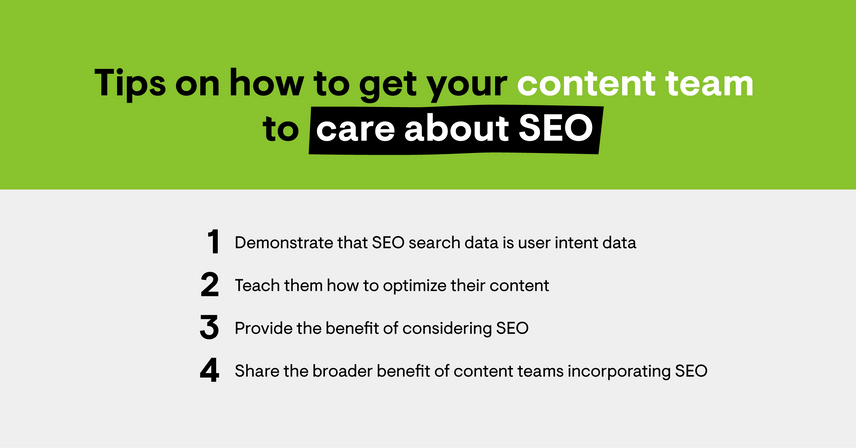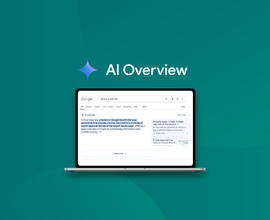How To Inspire Content Teams To Care About SEO
Incorporate SEO into your content team's work by proving its value. Read on for the broader benefits and collaboration tips.
When organizations begin with SEO, they often start with a dedicated SEO specialist.
This person’s responsibilities are usually broad and include a range of duties.
They're often working alongside content teams with commercial priorities, who are driving content and working separately from SEO teams.
The biggest challenge then is getting a content team to care about SEO.
Just as you need your dev team to understand SEO 's priorities, it's essential that you inspire your content professionals to support your SEO goals.
Here's how.

Why content teams need to care about SEO
Some of the duties the new SEO specialist can include:
- Measuring and understanding SEO and reporting on performance.
- Assessing the technical SEO of the site(s) they work on and working with the development team to address challenges.
- Creating a structured strategy for SEO.
- And identifying high-priority risks and opportunities to optimize and create new content.
Because teams outside the SEO team manage all other content creation and improvement, there is a risk of missed opportunities for new content, superficial understanding of user requirements, and unintentional de-optimization of content found via search engines.
SEO specialists and teams can react to the content's high-priority risks and opportunities, and embed SEO understanding and considerations into its processes.
It is one of the most effective ways to improve the depth and breadth of a site’s organic search presence and maximize its potential.
Demonstrate that SEO search data is user intent data
To work out how SEO and content teams can work more closely together, first understand where their interests are aligned.
Content teams’ KPIs are often centered on engagement metrics:
- How many users entered the site via their pages?
- How long did they spend on the page?
- How did the content of that page influence where they went next?
Content creators need to be highly tuned into the needs of the people they’re writing for to maximize all these measurement areas.
At this point, it’s an SEO cliche that “nobody lies to their search box,” but there’s a reason we repeat it so often.
Data on search engineSearch Engine
A search engine is a website through which users can search internet content.
Learn more queries helps reveal exactly what people are looking for, how they’re searching for it, and how many people are searching for it, and SEO teams hold the keys to all of that information.
By giving content teams access to user search data, both teams can increase their visit numbers and – most importantly—provide more value to their customers.
Initially, this often involves supplying keywordKeyword
A keyword is what users write into a search engine when they want to find something specific.
Learn more research directly, but to avoid your team becoming a bottleneck in this endeavor, you’ll need to provide tools to do their own research.
Teach them how to optimize their content
Once they know what their users are looking for and how, your content team will need to know how to get their work into a position to be found: The first page of the search results.
As an ex-teacher and SEO professional, the biggest tip I can give is to keep it simple.
We know that every part of SEO is steeped in nuance and that the answer to every question begins with “it depends.”
But your aim here is to make content creators feel confident to start optimizing their work, so keep to a few key guidelines that are easy to follow.
They should know best practices for optimizing metadata and structuring a piece of content and how to analyze top ranking results for a term to gauge the ideal length and format of top-ranking content.
Tools like SEO browser extensions can make this easier by providing header tag information and word counts.
Prove the benefit of considering SEO
At this point, if you’ve done your job well, one or two members of the content team have likely taken a particular interest in SEO.
They’ll be the ones asking the good questions and following up with you to validate their research and plans.
Keep these people on your side!
Now that the team is doing the basics of optimizing content for search engines, you’ll need to encourage them to keep going and continue building on their skills.
The best way to do that is by showing results.
As already discussed, content teams’ KPIs usually include traffic entering the site via their pages.
Proving that their efforts increase these numbers by capitalizing on search interest will renew and reinforce their enthusiasm.
Plus, this will serve as a great case study to encourage others to follow suit.
Tracking keywords and showing changes in rank will allow them to see tangible improvements from their work, as will tracking and reporting on changes in organic sessions and clicks from Google Search Console .
This is where having an enterprise SEO platform proves its worth by working with the team to create dashboards that curate all the SEO data related to content, making it easy to self-monitor and identify wins and areas of improvement, and including SEO metrics in their understanding and reporting of the success of their work.
The broader benefit of content teams incorporating SEO
The most obvious and direct implication of a content team incorporating SEO into their workflows is that more of the content on a site will be optimized than would be achievable by the SEO team alone.
This helps to make the SEO of a site more resilient, as its presence in the search results will be less reliant on only a few high-priority pages and keywords that the SEO team has the time to prioritize, along with all of their other responsibilities.
In addition, search interest and understanding of users will often lead to SEO data being the impetus for creating new content. Content created with users in mind (and with actual data to enhance understanding of what users want and need) will often have much better engagement and interaction than when based on assumptions.
As the team recognizes the value of the new approach, SEO metrics are likely to make their way into case studies and reporting.
This, in turn, will be fed into more senior stakeholders, raising the profile of SEO interests via internal advocacy, which can lead to increased profile and support, and increased investment—without you needing to distribute a single envelope stuffed with cash.
This article was originally published by Search Engine Journal on 6/3/2022.







